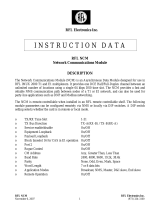9
RS-232 ↔CURRENT LOOP INTERFACE CONVERTER
The RS-232 ↔Current Loop Interface
Converter (CL050) is a bidirectional
self-contained unit that enables the
interconnection of a digital
20/30/60mA unipolar current-loop
interface with an RS-232 interface. The
CL050 cannot be used with an analog
current loop (4 to 20 mA) or bipolar
current loop.
Current loop was designed to transfer
data in a noisy environ-ment with as
much integrity as possible. The
maximum distance that the CL050 can
be placed from other devices on the
current loop (see Chapter 1) is based
on using 24 AWG under ideal
conditions, with the CL050 designated
as the active device in a point-to-point
configuration.
The CL050 can act as either an active
or passive device on the current loop.
As an active device, the CL050 supplies
20, 30, or 60 ma loop current at 18
VDC for operation. As a passive device,
the CL050 will not supply loop current,
but it will operate with 20, 30, or 60 ma
unipolar current at up to 30 VDC.
WARNING!
Only one device on the current
loop may be active. If more than
one device is active, each of the
devices will be permanently
damaged.
Refer to Sections 4.1 and 4.2 for
instructions on testing the current loop
and connecting it to the CL050.
Switch selections allow for half-duplex
or full-duplex operation; 20, 30, or 60
mA loop current; and configuring the
CL050 as either DTE or DCE.
Two LEDs monitor data flow.
If you ordered the CL050A-R2, you
should have received cables with it.
A 220-volt power supply (CL050E) is
also available.
2. Introduction
Figure 2-1. With the CL050, you can interconnect a
current loop interface and an RS-232 interface.
Current
Loop
Device
CL050
Device using
RS-232 Interface





















